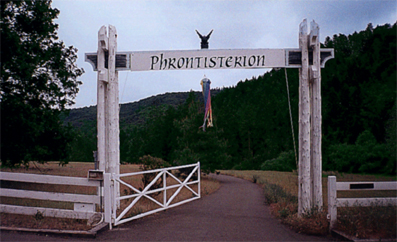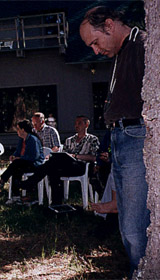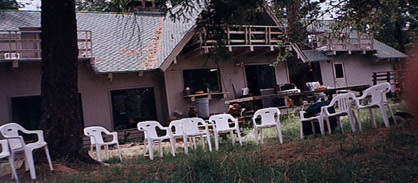|

The next morning I rose late because I also did not have an alarm clock. Went for a swim and then found the phrontisterion on Chris' 40 acres in the hills. Nothing had started yet and folks were milling around eating donuts and drinking coffee while the chairs were set up in a circle below enormous ponderosa pines. Shortly, Chris gathered this group of 22 and the phrontisterion began. Chris began the introductions with an opened ended story describing himself as the fairest of all dwarfs among this motley crew and segued to his right as the introductions continued and the story developed. There were all sorts of folks in the circle. There were folks from Canada, Germany, Scandanavia and the US. There were CEOs from software companies. There were folks who announced that they had recently quit Microsoft and folks who hoped to eventually quit other very high profile corporations and make their livings designing interactive fictions. There were academics like myself and producers from LA. There were science fiction writers interested in romance and computer programmers interested in emergent behaviors and artificial personalities. There were a couple of business folks there
 because they thought something 'cool' might emerge. After introductions Chris laid down the ground rules for how the phrontisterion would work. We would be there for 2 whole days and we had 12 questions to deal with:
because they thought something 'cool' might emerge. After introductions Chris laid down the ground rules for how the phrontisterion would work. We would be there for 2 whole days and we had 12 questions to deal with:
- Who are we and why are we here? (orientation and introductions)
- Should we piggyback on the games industry or start afresh?
- Who will be our customers?
- What lessons, positive and negative, can we learn from related technologies/industries?
- What new technologies are available?
- What do we want from an ideal technology, artistically and technically?
- What's our business model? Should we sell over the web or in stores?
- Artistically, are we literature, cinema, games, or...?
- Can we bootstrap our industry or will we need big launch funding?
- Where will we find the talent to staff our industry? What existing talent pools can we draw on?
- How can we overcome "Two Cultures" frictions?
- What have we learned here and where do we go from here?
We would continue discussing each question as long as there were at least 12 folks in the circle. When the discussion was not of interest we would get up and vote with our feet and go for a walk or discuss something of greater interest among ourselves. There would be a short 10 minute break and the discussion of the next question would begin. This was a very effective way to manage discussion and while Chris was nominally the discussion leader he rarely had to 'manage.'

Most of the early discussion had to do with the possible relationship the interactive fiction industry has/should have/should not have with the computer game industry. Remember, most of the folks in that circle either are or were game developers. The question is obvious but there was no consensus. Some folks felt as if it was obvious that computer games are interactive fictions so the discussion was moot. Others felt as if the two areas were completely different but the audience was the same. Still others felt as if interactive fictions are very different from games and should have no connection to the game industry because the association would create expectations which interactive fiction can not and should not meet. Since interactive fiction is a literary reference there was discussion of how this new media can be best distributed. The net is obvious but what about book stores which are open late into the evenings with patrons interested in fiction and stories? Again, no consensus.
The hot area of discussion began with a discussion of technologies such as Chris' Erazzmaton, the Oz project, Improv and VRML but it quickly becam obvious that there was some disent from the 'real' writers in the circle. Laura Mixon, the sci-fi writer, who worked with Chris' technology pointed out that writing 'Shatter Town' an interactive fiction took almost 17 months due to technical problems, her lack of understanding of the tool, The fact that the software was still evolving didn't help. For the writer, it is much easier to just write a book than it is to write anything interactive. She wrote 'Shatter Town' for the experience but there is a major problem for writers when their words are entombed in software which may not exist in a year or two. Other writers in the group also voiced a desire for tools which will allow their words and work to flow through technology rather than being entombed. HTML is an obvious choice but it is very inadequate for truly interactive writing. The problem is that the pencil for interactivity does not exist yet. Big problem for writers!
The idea of online worlds such as Ultima, EverQuest and Furry Muds were discussed. These are worlds where hundreds of thousands of folks go to 'role play' story, to make believe they are in King Aurtur's Court, that they are Lancelot and Guinivere. These are worlds where they, the interactors, create totally new and original characters. But, traditional dramatic tension creates its own tension if it is your character who must die in order to maintain the tension.
The two cultures discussion was a true eye-openner because as soon as the issue was raised the most technical folks in the group just up and left the circle. No discussion. There were about 15 folks left in the circle. Most folks left in the circle felt that most children today do not suffer this divide. They are as comfortable with programming and 3D modeling as they are with storytelling. For most in the group the university was blamed as a major contributor to the two cultures by their time honored arts, humanities and science colleges and departments which compartmentalizes students into almost self selecting groups. Another big issue was economic: writers are paid crap compared to programmers. No way around that one.
Eventually we reached the end of the second day. Many questions were raised and few were answered. But that was ok. Interactive storytelling is new and like all media before it it will take some time to come into its own. McLuhan pointed out that the content of every new medium is an old medium: film munched on theater; photography on painting; television on film and so it goes. Interactive fiction which seems to be munching both the computer game and storytelling at the same time. Eventually the form of the new media reveals itself and it will be unlike anything we ever imagined. Remember the the original purpose of the phone was to deliver music into the home.
Chris was right there is a divide but not necessarily C.P. Snow's divide. There are chasms between the game and the story, between the market and the artist, between the writer and the programmer, between space and narration, between interactivity and drama, between the desires of men and women. Chasm after chasm, conflict after conflict. In Aristophanes' "The Clouds" the Phrontisterion did not have a happy ending. Socrates and his pupils were ridiculed, and at the end of it, their school, the Phrontisterion, was burned to the ground. Chris' Phrontisterion looks to have a much happier ending. Each person at this years Phrontisterion is allowed to invite two others for next year which will probably bring attendance to 50+. Next year there will be even less agreement. Camps will form. Media will be designed. Markets will be created. Money will be made and a new industry will emerge.
So why is interactive storytelling important?
Interactive storytelling is definitely first cousin to the computer game but it is also first cousin to film and TV and more importantly to the book and reading in general. It is just human storytelling being filtered through yet one more medium designed by human beings to communicate with other human beings.
It is an unmistakable fact that reading is not popular among young people. According to the 1998 National Assessment of Educational Progress only 40% of high school seniors read at or above their grade level. 27% percent of all high school seniors never read on their own or for pleasure (37% just for guys). Every day 3 million books are checked out of libraries at the same time 6 million videos are rented. Like it or not we seem to be becoming an aliterate culture. I say seem because it is also an unmistakable fact that the internet is probably the greatest literary machine ever invented and that includes books. It is impossible to actually use the internet without reading. So, considering that the younger generation averages nine hours a week surfing the Web, nearly 38 percent longer than the average adult Internet user ("The Net-Powered Generation," Forrester Research) then you have to see that the future of reading is online which is inherently interactive which leads me back Chris Crawford's phrontisterion on interactive storytelling.
The no brainer
If you want kids to read then you give them the content they want to read in the form they want which is going to be a highly interactive format. We make the medium and the medium remakes us. In the 60's music and television remade the boomer generation into a generation their parents didn't recognize. Today there is another remake going on and it is our new interactive media which is remaking the kids. Kids are being remade to expect to interact, to lean in and make a difference. They do not want to read or watch passively. I haven't had to tell my son to turn off the TV in years but I have had to get him off line. Given the chance he will sit there all night reading and writing ... just like the old days!
I can not imagine a single area of human thought or activity which can not be embodied in a print-based book or magazine and I also can not imagine a single area of human thought or activity which can not be embodied in an interactive storytelling medium. I can imagine many areas which can be better embodied in interactive storytelling than in paper-based print such as science, math, art and music.
So, is is Chris Crawford's phrontisterion on interactive storytelling important? You make the call. for my part I'll just say: Duh!
An aside
As an aside, shortly after Oregon I went to the Canadian film center to
teach game design to a roomful of high school guys. On day two we were discussing ideas, trying to figure out what game ideas would work and what wouldn't, trying to figure out what was worth spending 3 weeks developing. Just into the discussion on day two an idea popped up which no one could deal with. A 13 year old boy raised his hand and said, "I don't know, it just doesn't work for me, the story isn't there, I need a good storyline."
Some things never change.
The story was the bushman's most sacred possession. These people knew what we do not; that without a story you have not got a nation, or culture or civilization. Without a story of your own to live, you haven't got a life of your own.
-Laurens Van Der Post, Lost World of the Kalahari.

Sincerely, Thom , your maitre d'Igital for the CafeTechnos.
|